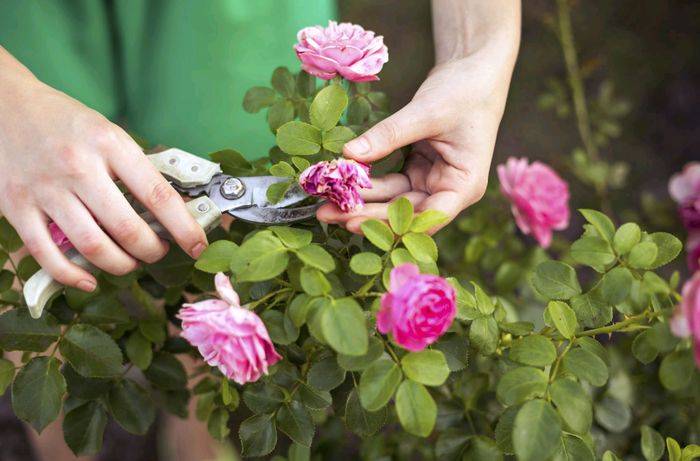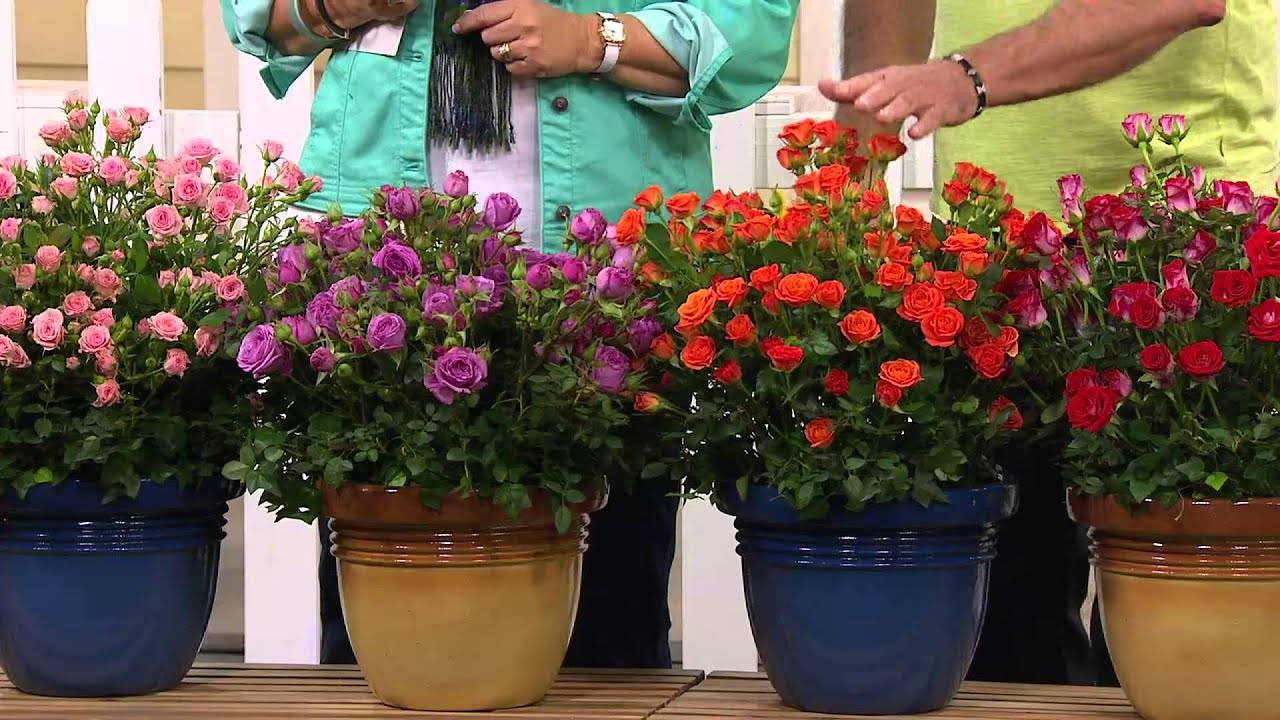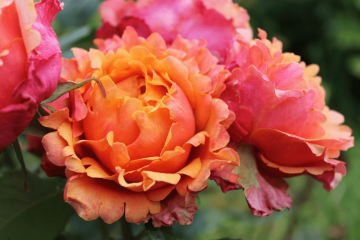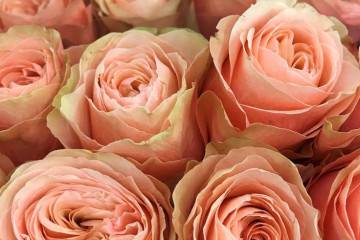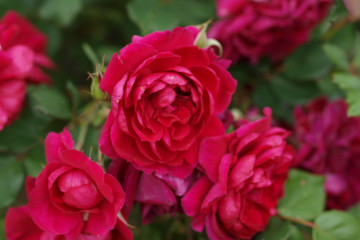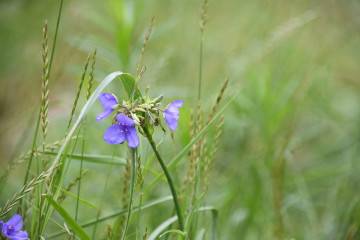Indoor rose - how to care, reproduction
Content:
A miniature rose is a wonderful gift for an amateur florist. After all, to curb garden culture and make a real garden in your home is the dream of many. But before breeding this beauty, you should study all the principles of care and conditions of detention.
Indoor rose - what kind of flower is it, what family it belongs to
Mini rose is a small shrub up to 50 cm in height. The appearance does not differ from the classic rose bush. Only its green shiny leaves are tougher. The beauty is a representative of rosaceae, like an ordinary garden rose.
Brief description, history of origin or selection
There are more than 300 varieties of mini-roses. A mini-beauty migrated from the garden, from miniature varieties of garden Bengal roses. China is considered the birthplace of small bushes, from where it was brought back in 1810.
Varieties of indoor plants with names, what they look like
The variety of species is based on the difference in shape and color of the miniature beauty's bud. Each bush has its own peculiarity and uniqueness.
Baby Masquerade
Derived from the standard sized garden variety Masquerade. The buds of this rose change color as it blooms. At the very beginning of flowering, the petals are yellow, lemon-chrome. Further, the outer petals begin to turn pink, then turn red. At the end of flowering, the inside of the bud will be slightly pink, and the outer petals will be crimson.
Angela Rippon
The most beautiful rose bush amazes with the color of its petals. Delicate, carmine pink color will not leave anyone indifferent. The bush is quite tall, up to 40 cm in height. Blooms profusely throughout the season, but needs regular feeding to maintain color. For indoor conditions, it requires maintaining humidity and regular watering. Can become a decoration of the street in a flowerpot or flower bed.
Easter Morning
Easter Morning is the first to bloom among its mini-siblings. It blooms profusely and continuously with creamy white flowers. The buds are relatively large, very beautifully shaped, full. The bush is medium-sized, compact and dense. Suitable for breeding among novice florists, as it is resistant to fungal diseases.
Fire Princess
Bright unforgettable colors deserve attention. The petals are colored orange-red, with a golden tint. As it blooms, the color becomes richer and brighter. Blooms in waves from mid-spring to autumn. A compact small bush barely reaches 30 cm. Requires increased attention in indoor breeding, is susceptible to fungal diseases.
Hummingbird (Colibri)
The golden yellow flowers of this variety are gorgeous. Stuffed dense buds bloom in 4-5 pieces.on one stem, exude a delicate tea aroma. In comparison with the size of the bush, the inflorescences are large, up to 4 cm in diameter. The bushes are compact, no higher than 30 cm, the greens are dense, dark green.
Caring for a room rose at home in a pot
Why is it so difficult to keep a purchased mini beauty. The miniature bushes sold in flower shops were grown in greenhouses. This means they had special conditions of existence. Fully consistent with rapid growth and abundant flowering.
In greenhouse conditions, flowers grow under the following conditions:
- high humidity;
- abundant lighting;
- irrigation mode with special purified water;
- regular feeding;
- constant applications of growth stimulants.
After the purchase, the flower is brought to the conditions of the apartment, where it is faced with dry air, a light source on one side (window), tap water and another mode of irrigation and fertilization (if any). In such conditions, the plant experiences stress, begins to dry out, shed its buds and soon dies.
The nuances of leaving after purchase
To preserve the plant and admire it for many years, you should take radical measures in adapting to the living conditions of the apartment. In any case, the flowering will be short-lived, as the conditions of detention have changed dramatically. The flower will drop its buds, and the already blooming ones will not bloom for a long time.
To save the plant and prepare it for living in an apartment, step-by-step adaptation should be carried out:
- The flower should be placed in the brightest place in the apartment. The east or west side is fine.
- Do not remove the protective bag for 5 to 7 days. It maintains the desired level of humidity and the created microclimate.
- After a week, the pot is removed from the bag. All dried and damaged leaves are removed. If the bush is too thick, you need to cut off the lower leaves, which interfere with free ventilation.
- Cut off all flowers and buds. The inflorescences are cut along with the shoot. The length of the cut shoot with a flower is 5-8 cm.
- After pruning, the plant should be transplanted. Purchased flowers are planted in shipping soil that does not contain any nutrients. A universal garden soil is suitable for transplanting.
- In gift pots, several bushes are often planted to make the flower look thicker and more beautiful. It must be transplanted by separating it from each other and planting the bushes in separate pots. The roots should be freed as much as possible from the old soil, for this you need to soak it well with water.
- During transportation, the flower could acquire a fungus. If damaged leaves with gray rot are found, they should be removed with a mealybug. If there are black spots at the base of the stems, the shoot should be cut off completely.
- For the treatment and prevention of fungi, new soil is spilled with a fungicide. The green part of the bush is carefully sprayed with the same solution.
After transplanting, the pots need to be covered with a jar, a cut bottle to create a greenhouse. It creates optimal humidity for successful rooting and will save apartments from dry air. Ventilate daily for 10-15 minutes.
The care regimen should consist of abundant lighting, adherence to temperature conditions, regular abundant moisture and fertilization.
Conditions of keeping and growing
If the care is correct, the rose will delight with abundant flowering from early spring to mid-autumn. The decorative effect is preserved thanks to regular pruning. The average lifespan of indoor mini-roses without loss of decorativeness is up to five years.
Illumination and temperature conditions
A lot of light is the key to active growth and flowering.The light should be diffused, if the windows are south-facing, you need shading at noon. The best directions are east or west. If the pot is on a windowsill, it is important to protect it from heating the soil. Keep away from batteries and direct sunlight.
Summer temperatures are tolerable up to 25 ° C. If the thermometer rises higher, additional humidification of the air around the pot is required. In winter, the plant should organize wintering. In sleep mode, the temperature should not rise above 10 ° C.
Watering rules and humidity
It is necessary to water abundantly during the active period of growth and flowering. Since the end of February, watering has been gaining momentum. And already in the summer months, it is important to ensure that the earthy clod never dries out. During hibernation, watering is reduced to a minimum.
The rose loves moisture and spraying. Daily routines will be beneficial. Spraying should be done in the morning so that the droplets have time to dry and not burn the leaves at noon. A warm shower can be arranged once a week.
On hot days, the pot is placed on pallets with damp pebbles or expanded clay. You can put containers with aqua soil near the pots of roses. The plant will not tolerate overheating.
Top dressing and soil quality
Since the beginning of spring, nitrogen-containing fertilizers are applied twice a month for active growth of green mass.
Feed is also needed during flowering. Ejecting buds takes a lot of energy. They need to be fed once every two weeks with complex fertilizers containing potassium and phosphorus. They are responsible for the formation of buds and the rich color of the inflorescences.
Flower container size
The bush pot should be medium in size. The presence of holes and a drainage layer of at least 2 cm is obligatory. With the next transplant, the pot needs more in diameter by just a couple of centimeters.
Pruning and replanting
Pruning should be done at the very end of wintering. The procedure is needed for the following purposes:
- awakening of the kidneys;
- bush formation;
- building up young shoots;
- removal of old, dry and damaged branches.
Pruning doesn't have to be gentle. Good shoots are cut to 3-4 buds, their length should not exceed 10 cm. Bad and damaged branches are removed completely.
Preventive pruning is carried out during the entire active period of growth. Withered flowers must be cut off so that the flower does not waste energy on the formation of the seed. Leaves that begin to turn yellow and dry must be cut off immediately.
A plant transplant is needed once every two years. The soil needs light and nutritious. Peat and sand are added to the garden soil. Adding humus is acceptable.
Features of flowering plants
The mini-rose blooms actively throughout the warm season. Flowering is often accompanied by a pleasant aroma. The ejection of buds is supported by abundant lighting, top dressing and constant soil moisture.
A period of activity and rest
The active period begins at the end of winter, when the first buds begin to wake up. After pruning, the room temperature gradually rises, the irrigation mode is restored. The pot is placed in a sunny place and spraying is resumed.
With the onset of stable heat, the rose can be sent to the open air. Balcony, loggia, open terrace, flower bed are suitable for her comfortable existence. The bush tolerates daily temperature drops well.
In the fall, complementary foods are gradually reduced, excluding nitrogenous fertilizers, so that the plant prepares for wintering. If the pot was in the open air, at the end of August it is brought indoors, completely stopping complementary feeding. From the end of autumn, the indoor temperature is reduced to + 10 ° C. The flower sheds its leaves and enters a dormant state. The temperature for a comfortable sleep of the rose is from 2 to 5 ° C.Watering is reduced, only occasionally the soil is wetted. Drying out is unacceptable in the cold season.
It happens that the sleep mode cannot be organized for a rose bush. In this case, wintering should take place in the house at a temperature not higher than +15 ° C. Additional lighting is needed. Fertilizers are applied once every three weeks, with a weak solution. Moisten and spray regularly.
Types and shape of flowers
The flowers of the roses have a rounded bowl-like shape. The different varieties boast velvety full buds in a wide variety of shades.
Propagation of a rose bush by cuttings
The easiest way to propagate a rose is with cut shoots. Cuttings are cut from May to September. The cut is made oblique and the cutting is immediately lowered into water or into a mixture of sand and peat. Rooting takes place quickly. Organize a greenhouse regime for young cuttings and carefully look after them.
Growing problems, diseases and pests
The rose is very susceptible to attacks by fungal diseases and pests. The rose tree should be kept away from other indoor plants that might infest it.
How to deal with them
Dry air provokes the appearance of pests, and the accumulation of moisture at the base of the cuttings is a breeding ground for fungi. It is important to follow the rules for caring for a rose so as not to face these problems. Conduct preventive examinations and spraying the plant with fungicides and insecticides.
At first glance, it may seem that caring for rose bushes involves a lot of trouble. After all, the beautiful rose is not for nothing called the queen of all colors, which means that she needs truly royal care. However, if you build the correct sequence of actions and watering regime, taking care of the rose will only be a pleasure.



